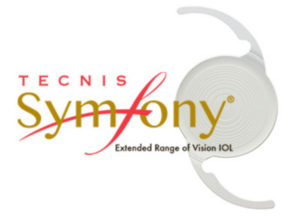


Are you over the age of forty and struggling to read text on a smartphone or read your favorite books? You may have presbyopia. Presbyopia occurs when your eyes begin losing their ability to see objects up close and is a natural part of aging. People who have presbyopia will often hold objects like books or cell phones further away in order to see them more clearly. If you have presbyopia and need cataract surgery, Eye Physicians of Long Beach offers the Tecnis Symfony© IOL, a unique intraocular lens that can mitigate the effects of presbyopia and reduce the need for glasses.
The Tecnis Symfony© IOL is an intraocular lens that’s implanted during cataract surgery. During the procedure, your cataract surgeon will remove the old, clouded lens and replace it with an artificial lens. With Symfony©, your artificial lens will allow you to see clearly at all distances and give you your vision back. The Symfony© lens was approved by the FDA in 2016, and is considered a premium IOL. Medicare may not cover the costs associated with this premium IOL, but if you are able to afford it and are looking to reduce your dependence on reading glasses, the Symfony© IOL is a great choice.
In order to be considered a candidate for the Symfony© lens, you need to have presbyopia, and have cataracts. Symfony© is only implanted during cataract surgery. In addition to giving patients clear vision at all distances, Symfony© is also approved for patients who have astigmatism and presbyopia, allowing a larger number of people to benefit from the joys of clear vision. During your cataract surgery consultation with Eye Physicians of Long Beach, your cataract surgeon will mention several IOL options, including the Tecnis Symfony© premium IOL.
There are several different kinds of IOLs currently on the market, making the choice of what’s best for you more difficult. For patients that are only looking to remove their cataracts and don’t mind wearing glasses for everyday activities, the Symfony© IOL may not be the best fit. However, for patients that are looking for a life free of the hassles of glasses and presbyopia, the premium Symfony© lens is worth researching.
One of the biggest differences between the Symfony© IOL and other lens options is the incidence of glares and halos. Studies have consistently shown that patients who opt for the Symfony© IOL rather than other standard IOLs report less halos and glare around lights at night. This is important if you plan on driving at night consistently after cataract surgery. In addition, with the Symfony© lens, patients are able to see at all distances clearly, not just up close or far away. Standard monofocal IOLs can only correct seeing objects up close or far away, but not both The Symfony© lens is the only IOL that is able to correct your vision at all distances.
Life after cataract surgery means recovering your vision, and after cataract surgery with the Tecnis Symfony© IOL, you’ll be able to see as you have never before! Although all patients are different, most stop relying on glasses to see after Symfony©. Fully recovering after cataract surgery takes about 8 weeks, during which your vision may seem unstable and blurry. After the recovery period, your vision will be clear at all distances! Tasks like reading or writing an email on your phone will be easier to accomplish, without the frustration of having to search for your reading glasses. Life after Symfony© is the start of clarity, acuity, and clear vision at all distances!
Schedule your cataract surgery consultation with the doctors at Eye Physicians of Long Beach today! It’s time to start your clear vision journey.